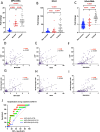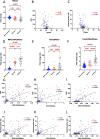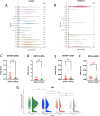Impaired balance between neutrophil extracellular trap formation and degradation by DNases in COVID-19 disease
- PMID: 38454482
- PMCID: PMC10919029
- DOI: 10.1186/s12967-024-05044-7
Impaired balance between neutrophil extracellular trap formation and degradation by DNases in COVID-19 disease
Abstract
Background: Thrombo-inflammation and neutrophil extracellular traps (NETs) are exacerbated in severe cases of COVID-19, potentially contributing to disease exacerbation. However, the mechanisms underpinning this dysregulation remain elusive. We hypothesised that lower DNase activity may be associated with higher NETosis and clinical worsening in patients with COVID-19.
Methods: Biological samples were obtained from hospitalized patients (15 severe, 37 critical at sampling) and 93 non-severe ambulatory cases. Our aims were to compare NET biomarkers, functional DNase levels, and explore mechanisms driving any imbalance concerning disease severity.
Results: Functional DNase levels were diminished in the most severe patients, paralleling an imbalance between NET markers and DNase activity. DNase1 antigen levels were higher in ambulatory cases but lower in severe patients. DNase1L3 antigen levels remained consistent across subgroups, not rising alongside NET markers. DNASE1 polymorphisms correlated with reduced DNase1 antigen levels. Moreover, a quantitative deficiency in plasmacytoid dendritic cells (pDCs), which primarily express DNase1L3, was observed in critical patients. Analysis of public single-cell RNAseq data revealed reduced DNase1L3 expression in pDCs from severe COVID-19 patient.
Conclusion: Severe and critical COVID-19 cases exhibited an imbalance between NET and DNase functional activity and quantity. Early identification of NETosis imbalance could guide targeted therapies against thrombo-inflammation in COVID-19-related sepsis, such as DNase administration, to avert clinical deterioration.
Trial registration: COVERAGE trial (NCT04356495) and COLCOV19-BX study (NCT04332016).
© 2024. The Author(s).
Conflict of interest statement
The authors declare no competing interests.
Figures




References
Publication types
MeSH terms
Substances
Associated data
Grants and funding
LinkOut - more resources
Full Text Sources
Medical

